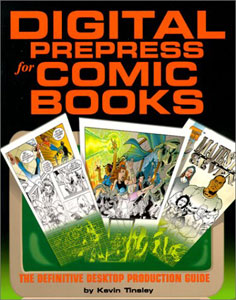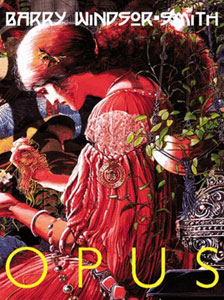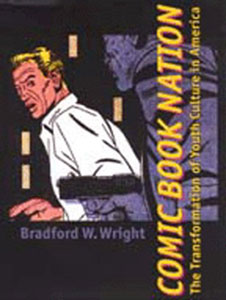|
|

|
| . |
|
|
|
|
|
|
| KEVIN
TINSLEY |
 |
DIGITAL
PREPRESS
for
COMIC BOOKS
The Definitive Desktop Production
Guide |
by Kevin Tinsley
w/ Tim Smith, Scott Koblish, & Greg Schigiel |
Paperback: 208 pages
Stickman Graphics
ISBN: 0967542308 |
|
$36.95

|
| This book is
the ultimate reference used by professionals throughout the industry. With
over 300 illustrations, and detailed instructions, this manual will provide
the answers and solutions you will need to successfully print a magazine. |
|
|
|
| Whether
you are planning to publish your own comics, or want to provide the best
reproducable art possible, this item is a must have for your professional
library.
Computer Publishing magazine
01/2000
"Recomended for anyone working
in comics." Four star rating.
.
The Book Reader Spring/Summer
2000
"An extraordinarily knowledgeable
guide for getting your cartoon pages off of the drawing board and onto
a computer disk"
.
Comics Corner April 2000
" It is a must have book-
well written, easy to understand and filled with examples."
.
About the Author
Kevin Tinsley is considered
to be the leading expert on desktop comic book publishing. With over a
decade of experience, he has played a major role in the transformation
of the entire industry. He currently works as a prepress consultant and
separator for several major companies. |
|
|
|
|
|
|
| BARRY
WINDSOR-SMITH |

|
OPUS:Volume
One |
| by Barry Windsor-Smith |
Hardcover: 176 pages
Fantagraphics Books
ISBN: 1560973676 |
$39.95

|
| The art of comics
legend Barry Windsor-Smith is collected in this stunning hardcover volume.
Barry Windsor-Smith has been
a pop culture icon since his fantastic and meticulous drawings brought
Conan the Barbarian to life in the pages of Marvel Comics beginning in
1970. Over a thirty year period since, he has continued to forge new channels
of personal expression in the storytelling arts. |
|
|
|
| With this first
volume of BWS: OPUS, the acclaimed artist and writer of romantic, witty
and heroic fantasies pulls hard on the rudder of Reality to turn back against
the course of Time. But this is no "time-travel" caper, it is the real
thing. Barry Windsor-Smith has a past; a history to tell of Extraordinary
Experiences that are no less exciting or bizarre than any of his literary
or painterly creations.
The true story of BWS, as
a lone soul caught up in the transcendent phenomena of Cosmic Experience
begins here, in his autobiography called OPUS.
Robert Anderton from
Nottingham, England:
A book of beautiful images
and cosmic revelations. 'Cosmic' isn't a word usually associated with the
work of Barry-Windsor Smith, and is more often used in connection with
his 70's contemporaries Jack Kirby and Jim Starlin. But in 'Opus', he even
manages to outdo Carlos Castaneda with his eloquently-told tales of mind-bending
transcendental insights. It's not easy for a writer to reveal himself in
this way (and BWS is certainly leaving himself open to ridicule), but it's
clear that the experiences he relates have left a sincere and lasting impression
upon him, and by implication, upon his work. Was Barry Windsor-Smith simply
the victim of a flux in the Space-Time Continuum during 1973, or was someone
at the local deli spiking his coffee with LSD? I don't know, but his tales
certainly made interesing reading. On the other hand, most people will
be buying this book primarily for the artwork, and they won't be disapointed.
The emphasis is more on portfolio-style single images than pages of graphic
narrative, and there really are some stunning images here. So what if some
of the plates run across the spine of the book? Mr Windsor-Smith is presenting
his life's work here, and if he's happy with the layout then who are we
to complain? |
|
|
|
|
|
|
| BRADFORD
W. WRIGHT |

|
COMIC
BOOK NATION:
The
Transformation of Youth Culture in America |
| by Bradford W. Wright |
Hardcover: 352 pages
Johns Hopkins University Press
ISBN: 080186514X |
|
$34.95

|
| "Congratulations
to Bradford W. Wright for penning one of the most comprehensive and readable
accounts of the pervasive effect that comic books have had upon generations
of readers throughout America, and indeed—the world."
—Stan Lee
|
|
|
|
Dennis Drabelle,
Washington Post Book World:
"...Trenchant, crisply written
and absolutely jargon-free, with plenty of enthusiasm but no idolatry--
and great fun to read."
.
From Publishers Weekly
Pow! Bam! Crash! Analysis!
According to this insightful and highly entertaining political and cultural
history of comic books, Superman was not just "fighting for the American
way"--he was inventing it. Comic books, perhaps the central staple of U.S.
youth culture, have been fundamental in both shaping and reflecting the
country's political, social, ethical and even sexual mores ever since Superman
made his first appearance on the cover of Action Comics in 1938. Wright,
a faculty member at the University of Maryland's University College, charts
how these popular pulp stories (over 100 million comics were printed in
1949) mirrored myriad, often conflicting, political positions: Superman's
first enemies were corrupt politicians and slum lords aligned against the
New Deal; '50s books reflected national anticommunist hysteria as well
as mixed messages about the Korean War; violent "crime comics" of the 1950s
reflected the decade's social unrest; Iron Man in the 1960s found his earlier
anticommunist politics shaken by the war in Vietnam. Wright explores how
the politics of the writers and artists, usually liberals and often Jewish,
were reflected in their work, while at the same time they had to conform
to frequently more conservative cultural standards that often led to a
backlash against the genre. By the late 1940s, comics were at the center
of a full-fledged cultural war; claims that they corrupted youth and caused
crime and juvenile delinquency, resulted in congressional hearings and
laws that banned the books. Carefully placing comics in their broader social
contexts and weighing seriously their critics' charges, Wright creates
an intelligent study not only of comics but of shifting attitudes toward
popular culture, children, violence, patriotism and America itself.
Copyright
2001 Cahners Business Information, Inc.
.
From Booklist
The comics, like jazz, is
an American popular art that has been enthusiastically adopted worldwide,
and the comics' brash sibling, the comic book, is even more quintessentially
American. Wright's readable study traces the history of comic books during
the past six decades and demonstrates the interaction between politics,
social trends, and popular culture in them. Early comic books adopted Depression-era
values; hence, Superman's first battles were against greedy capitalists
as well as criminal masterminds. In the early 1940s, comic-book heroes
fought Nazis and the Japanese and reflected wartime jingoism and racism.
After the war, crime and horror comic books came to be apprehensively regarded
by some as "harbingers of a degenerate and disturbingly confrontational
youth culture," and there was widespread censorship of the medium. Wright
points out that comic books preceded rock 'n' roll as an entertainment
marketed to youngsters rather than parents and thus were a key in developing
teenagers as consumers. Solid though seldom revelatory, Wright's book is
more a well-documented comics-industry chronicle than a penetrating social
study.
Gordon Flagg
Copyright © American
Library Association. All rights reserved
.
From Library Journal
At last, a substantive book
studying the effect of comic books on American culture and vice versa.
Wright (Univ. of Maryland's University Coll., European Division) departs
from the tired formula of celebrating comics' golden age in the 1940s or
focusing on one company's experiences. Instead, his extremely well-organized
book traces the genre's birth, expansions, and retractions from the 1930s
to the present. The fascinating result highlights an increasingly intriguing
interaction between pressing events in American society and what was written
and published on colorfully paneled pages. Wright's style is intellectual
but not lecturing, informed but not boorish, and he maintains an admirable
balance between minute detail and breezy highlight. Recommended for all
public and academic libraries looking to offer a truly worthwhile study
of comics as part of American culture rather than in the usual vacuum.
Chris Ryan,
New Milford, NJ
Copyright 2001 Cahners Business
Information, Inc.
.
As American as jazz or rock
and roll, comic books have been central in the nation's popular culture
since Superman's 1938 debut in Action Comics #1. Selling in the millions
each year for the past six decades, comic books have figured prominently
in the childhoods of most Americans alive today. In Comic Book Nation,
Bradford W. Wright offers an engaging, illuminating, and often provocative
history of the comic book industry within the context of twentieth-century
American society.
From Batman's Depression-era
battles against corrupt local politicians and Captain America's one-man
war against Nazi Germany to Iron Man's Cold War exploits in Vietnam and
Spider-Man's confrontations with student protestors and drug use in the
early 1970s, comic books have continually reflected the national mood,
as Wright's imaginative reading of thousands of titles from the 1930s to
the 1980s makes clear. In every genre—superhero, war, romance, crime, and
horror comic books—Wright finds that writers and illustrators used the
medium to address a variety of serious issues, including racism, economic
injustice, fascism, the threat of nuclear war, drug abuse, and teenage
alienation. At the same time, xenophobic wartime series proved that comic
books could be as reactionary as any medium.
Wright's lively study also
focuses on the role comic books played in transforming children and adolescents
into consumers; the industry's ingenious efforts to market their products
to legions of young but savvy fans; the efforts of parents, politicians,
religious organizations, civic groups, and child psychologists like Dr.
Fredric Wertham (whose 1954 book Seduction of the Innocent, a salacious
exposé of the medium's violence and sexual content, led to U.S.
Senate hearings) to link juvenile delinquency to comic books and impose
censorship on the industry; and the changing economics of comic book publishing
over the course of the century. Comic Book Nation is at once a serious
study of popular culture and an entertaining look at an enduring American
art form.
.
About the Author
Bradford W. Wright is on
the faculty of the University of Maryland University College, European
Division. |
|
|
|
|


